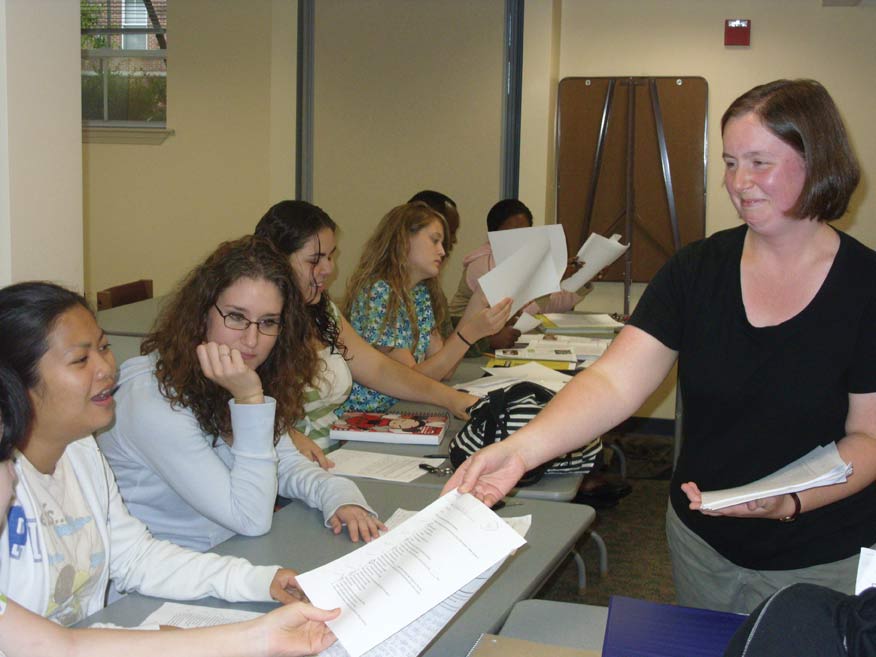
Cindy Lee Lamica would be on any long term care facility’s list of top employees. Originally on track to become a teacher, she ended up leaving college with three semesters left and went to work in geriatrics. After becoming certified as an activities director, she went to work in 2000 at Notre Dame Du Lac assisted living residence, Worcester, Mass., where her expertise in caring for people with memory impairment qualified her to direct its dementia care Harmony program.
And then, as the saying goes, life happened. With a young teenage son at home and another child on the way, Lamica decided it was time to consider her next career move, including getting her degree to improve her earning power. “I loved what I did, but there was very little opportunity for advancement in my profession,” Lamica recalls. “And then they suggested that I apply to go back to college through the Educational Bridge Center.”
An Idea Is Born
The Notre Dame Educational Bridge Center, located on the Notre Dame campus, evolved out of a labor crisis that began with certified nurse assistants (CNAs) and then grew to licensed nurses. It was a time of sign-on bonuses, extra vacation, and creative perks to lure licensed nurses into the facilities. But no sooner had they filled one vacancy when two more would open as nearby hospitals absorbed most of the available nursing pool.
In 2003, Notre Dame Du Lac had tried every strategy its managers could think of, but no amount of perks or marketing could solve what had become a double-digit vacancy rate that was on the rise.
Then, during a meeting of a consortium of 12 local facilities under the name of the Intercare Alliance, the solution suddenly appeared. Dean Messier, director of human resources for Holy Trinity Nursing and Rehabilitation Center, an alliance partner, listened carefully as the challenges were described.
Short of inventing these nurses, there appeared no way out of a cycle that was depleting budgets with overtime and agency fees, sinking staff morale as a revolving door spun staff in and out of the facilities.
“Why don’t we grow our own,” said Messier.
The idea of developing a pool of licensed nurses was intriguing for a number of reasons, the primary reason being to solve the nursing labor gap. There was also a considerable financial incentive for Notre Dame’s collective 12 facilities to solve the problem as it cost collectively more than $1 million annually to pay for the agency nurses who filled in uncovered shifts.
The churn of agency nurses and staff nurses who left for other jobs was also emotionally draining for other employees and residents, who the company felt would benefit from greater stability in its CNAs and licensed nursing staff.
A Bridge Is Built
At the heart of that strategy was the Educational Bridge Center, rooted in the tradition of the Sisters of Notre Dame, a teaching order committed to “educating for life,” which understood that education was the path to a better life for its employees and, by association, its residents.
Investing in employees began as a strategic answer to a daunting problem but quickly became a cultural shift in the facilities.
Word soon spread that the company was offering to raise employees from entry-level positions into a better-paying and more permanent career. Competing with hospitals for the same labor pool was over because the nursing candidates were Notre Dame’s own employees who had already expressed a preference for working in long term health care.
Jo-Ann Desjardin, Notre Dame’s director of human resources, recalls the noticeable shift that occurred within two years of the start of the program. “The first days were tricky, and then word started to get around that we had a program where we would pay for everything,” she says. “Now, nine out of 10 people who come here know about the program, so it didn’t just expand the career ladders for existing employees; we had extended that ladder to pull even more people into the profession.”
After structuring a unique arrangement with nearby Quinsigamond Community College, the Intercare Alliance applied for and received grant funding from state and private funding sources to prepare staff members. The program launched its first class in 2003.
Overcoming Challenges
There were some challenges along the way. For example, there was the practical problem of how—and where—these candidates would get the prerequisite courses they needed before they attempted college-level course work.
The selected candidates had the requisite passion and commitment for a career in nursing, but most had not pursued a license on their own because they lacked education or language skills, making career advancement daunting if not impossible.
The Educational Bridge Center quite literally became the bridge for these candidates by offering employees of the alliance facilities convenient access to classroom facilities on the Notre Dame campus for pre-college courses; General Educational Development, or GED, test preparation; and computer training. Thus, the center had filled the educational gaps that kept many candidates from realizing their dreams.
What is truly remarkable about the alliance program is embedded in the center. It is here, says Desjardin, where a once unattainable dream of going to college and earning a license in nursing takes shape and becomes real.
Most of our students who went on and earned their LPNs [licensed practical nurse certification] are now going on to the RN [registered nurse] program. It has changed their lives and their family’s lives,” says Desjardin. “Ninety percent of the candidates would never have had the opportunity to achieve what they have accomplished. I think that pride goes out of the building, they wear it everywhere they go, and it has spread like wildfire.”
The foundation for what has become the very successful Grow Your Own Nurses program in central Massachusetts is the collaborative effort of the Intercare Alliance, whose members shared the same intractable problem.
Budget concerns have also been alleviated. Notre Dame was spending tens of thousands of dollars every month to shore up its depleted ranks with agency staff and had nothing to show for it. Now, for about $10,000 per student for all tuition, fees, uniforms, and clinical equipment, they have a nurse who is not only solving a labor problem but has become the best advertisement for the opportunity of working in long term care.
Dreams Are Realized
For Lamica, whose mother, sister, and aunt were all nurses, this is a profession that makes her feel that her life is in balance. The Bridge program, she says, was the key, as she spent all her available time there preparing for and completing her course work.

In 2007, Lamica graduated Phi Beta Kappa. Her unfulfilled dream of become a nurse while managing the dementia program at Notre Dame has now been realized. “You look at it and then say to people, ‘Look at what my employer is doing for me.’ You feel more relaxed, and I realized that I want to be here for a very long time.”
Concern that the home-grown nurses would leave after their two-year commitment has also not materialized. More than half of the LPNs from the first graduating class in 2004 are still on the job, while 82 percent of the class of 2006 are also still working in their LPN positions or have gone on to earn their RN degrees.
And now they are joined by a new class of graduates who were pinned last June in a ceremony at Quinsigamond before a packed auditorium of family and friends.
“Whether they stay or not after their two-year commitment,” says Desjardin, “at the end of the day we have developed a nurse who is dedicated to the mission of long term health care. We started out to solve a labor problem, but what we have created is a work and learning environment that is not only transformational for employees but also gives our residents a sense of continuity of care.”
Katheerine Lemay, RN, MS, is chief executive officer/administrator of the Notre Dame Long Term Care Center in Worcester, Mass. Patricia Campbell is director of the Notre Dame Educational Bridge Center.